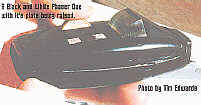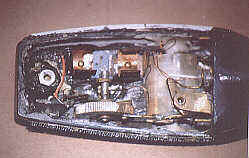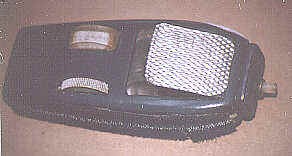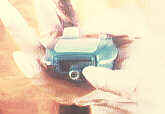The Black and Blue Phaser Ones
By Richard A. Coyle
Page 2
All right, what did work and how? Well, starting with the plate on the phaser
one, it was a piece of brass plate with a aluminum embossed foil glued to it or an
aluminum diamond imprinted plate. Just behind and partly under it was a 3/4" wide
«" round plexiglas rod. This is what most of us have been mistaking for the trigger
bar.
 Behind that was a thin round knurled knob protruding as a thumb wheel. Opposing that was a
«" round lens for the read-out of the settings. You raised the plate by rotating the
thumbwheel with, well... your thumb.
Behind that was a thin round knurled knob protruding as a thumb wheel. Opposing that was a
«" round lens for the read-out of the settings. You raised the plate by rotating the
thumbwheel with, well... your thumb.
As you turned this knob, a link inside the body connected from the wheel to the 1/2 round Plexiglas rod that sat partly under the top
plate (which was fashioned in the front with the Plexiglas at its rear) would turn into
the plate, forcing it to slide across the face of the Plexiglas rod and thus it would
raise as it slid up. This action would raise the plate about 1/4". Wait, there's
more. . . after the plate was at its fullest height, if you continued to turn the knob, a
small Plexiglas rod
connected from the wheel to the 1/2 round Plexiglas rod that sat partly under the top
plate (which was fashioned in the front with the Plexiglas at its rear) would turn into
the plate, forcing it to slide across the face of the Plexiglas rod and thus it would
raise as it slid up. This action would raise the plate about 1/4". Wait, there's
more. . . after the plate was at its fullest height, if you continued to turn the knob, a
small Plexiglas rod  telescoped out
of the brass tube in the front and just below center on the phaser one's body. But the
best is yet to come.
telescoped out
of the brass tube in the front and just below center on the phaser one's body. But the
best is yet to come.
This one's a dilly. Then and only then at the very end of the rotation,
at the highest setting, only then could you turn it a little further to light the light,
to fire the phaser one.
That means it could only fire on its highest setting which makes for a serious,
possibly fatal, design flaw. Maybe that is why the witch could not fire it??
makes for a serious,
possibly fatal, design flaw. Maybe that is why the witch could not fire it??









